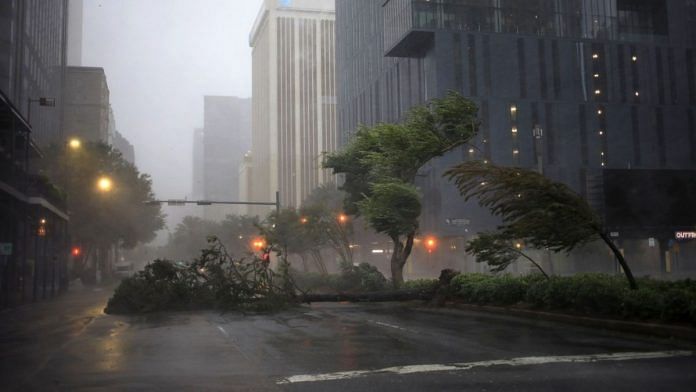Bengaluru: The US government Sunday declared the unusually strong Hurricane Ida to be a ‘major disaster’ for the state of Louisiana and released federal funds for the state’s emergency response.
The hurricane was first observed on 23 August as a tropical wave, which are troughs of low pressure, and then intensified from Category 1 to a Category 2 hurricane in a day. It became Category 3 within 12 hours and then rapidly intensified at unprecedented rates to a Category 4 hurricane within an hour.
The hurricane was expected to intensify further to Category 5 but made landfall as Category 4 on 29 August (local time), on the 16th anniversary of Hurricane Katrina. Katrina, which hit Louisiana in August 2005, is the strongest hurricane to be witnessed by the state. It has never seen a Category 5 hurricane so far.
Hurricanes are categorised on the Saffir-Simpson scale by the United States’ National Hurricane Center or the Central Pacific Hurricane Center. The scale has five categories and the strongest of these, Category 5, has sustained wind speeds of over 250 km/h.
Ida continued to remain a Category 4 hurricane for several hours despite landfall, causing severe damage to Louisiana, destroying many homes, uprooting trees, damaging infrastructure, and several major cities suffered a power outage. At least one person is reported dead.
At one point, strong winds from the hurricane even reversed the flow of the Mississippi River near New Orleans, which the US Geological Survey — a government agency that studies the country’s landscape — called “extremely uncommon”.
It is currently a tropical storm over land, with a continued threat of intense rainfall and winds of up to 95 km/h. Residents who had not evacuated are reportedly facing increasing flash floods.
Also read: What Cyclone Tauktae tells us about Arabian Sea & why the coast is seeing more severe cyclones
Hurricane Ida was unexpectedly strong even after landfall
Hurricanes form when warm air enables evaporation in the ocean and a central drop in pressure that draws the warm, moist and evaporated air in. As air is pulled in towards the central low pressure region, or the eye of the storm, it rises rapidly before condensing, releasing heat and cooling down, and then rushing back down to rise again with the heat.
The process repeats cyclically as the storm spins and grows in size and strength around the central low pressure area.
Ida’s central pressure was recorded to have dropped by 40 hectopascal (hPa) in just 12 hours when it intensified. In the region of the Gulf of Mexico, only two previous hurricanes — Allen in 1980 and Rita in 2005 — have dropped their central pressure at such a rapid rate.
According to National #Hurricane Center operational best track, #Ida's central pressure fell 40 hPa in 12 hr. Only 2 other #hurricanes on record (pressure consistently recorded since 1979), have had 40+ hPa pressure falls in Gulf of Mexico in 12 hr: Allen (1980) and Rita (2005). pic.twitter.com/8EvrETJVt6
— Philip Klotzbach (@philklotzbach) August 29, 2021
Warmer surface waters that feed the hurricane quickly can cause this rapid drop in pressure, which then results in increased wind speed.
Some experts believe that after reanalysis of hurricane data at the end of this season, Ida could possibly be upgraded to a Category 5.
After landfall, Hurricane Ida moved inland but unexpectedly continued to retain its strength, remaining a Category 4 hurricane over 4.5 hours after landfall. Hurricanes tend to weaken as soon as they make landfall.
According to meteorologists, this is likely the result of the ‘brown ocean effect’ where the extensive wetlands that cover the southeastern parts of the state’s coastline provide enough warmth from evaporating wet soil to sustain the hurricane.
This causes the hurricane to continue to behave like it would over the ocean.
Also read: Why Odisha is in the eye of a storm more often than other east coast states
Storm scales
Tropical cyclones are named when sustained winds reach at least 65 km/h. Depending on which part of the ocean they originate from and which meteorological agency categorises them, they can be called hurricanes, typhoons, or cyclones.
Tropical cyclones in the western hemisphere — in the North Atlantic Ocean and Eastern Pacific Ocean — are called hurricanes. Those in the western Pacific Ocean, within the Northern Hemisphere, are called typhoons. Tropical cyclones in the rest of the world, including North Indian Ocean, South and southwest Indian Ocean, Southern Pacific Ocean, and the Southern Hemisphere are called cyclones.
Tropical cyclones are ranked on one of five different scales used to measure tropical cyclone intensity depending on the central meteorological agency that monitors a region and names the storms. One of them is the Saffir-Simpson scale used in the US.
Typhoons are classified by the Japanese Meteorological Agency into four categories — Tropical Depression, Tropical Storm, Severe Tropical Storm, and Typhoon — with the Typhoon category having sustained winds of over 118 km/h as measured for 10 minutes.
The Indian Meteorological Department, meanwhile, categorises North Indian Ocean tropical cyclones into seven categories — Depression, Deep Depression, Cyclonic Storm, Severe Cyclonic Storm, Very Severe Cyclonic Storm, Extremely Severe Cyclonic Storm, and Super Cyclonic Storm, with the last one having sustained winds of over 222 km/h for three minutes.
The South-West Indian Ocean cyclones are categorised by Météo-France’s La Réunion tropical cyclone centre into seven categories — Tropical Disturbance, Tropical Depression, Moderate Tropical Storm, Severe Tropical Storm, Tropical Cyclone, Intense Tropical Cyclone, and Very Intense Tropical Cyclone (more than 212 km/h).
Tropical cyclones in the Southern Hemisphere are monitored by the meteorological services of Fiji, Indonesia, New Zealand, and Australia. They are also categorised into five numbers, with Category 5 having sustained winds over 280 km/h.
Also read: These are the ‘code red’ warnings in IPCC climate change report, & why it matters



